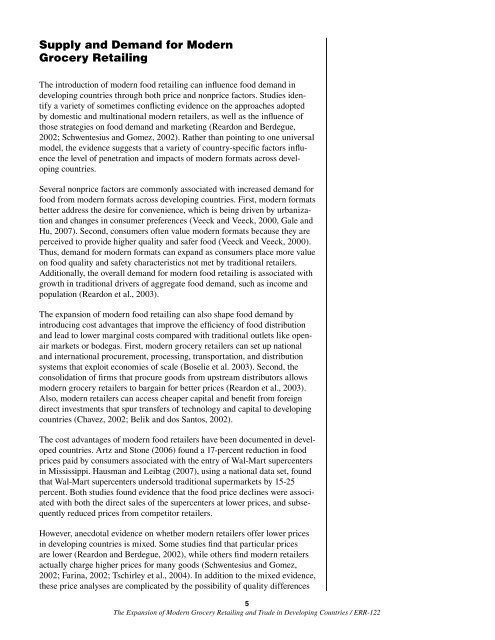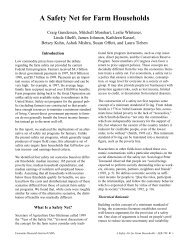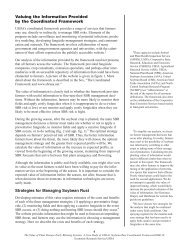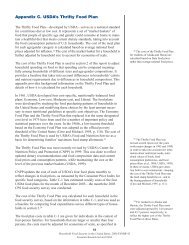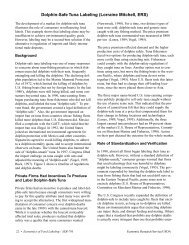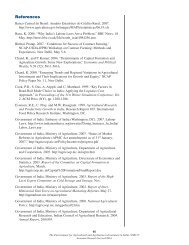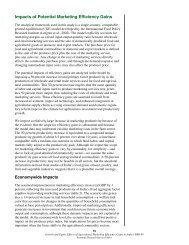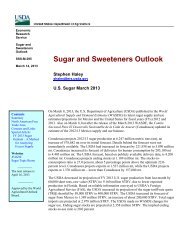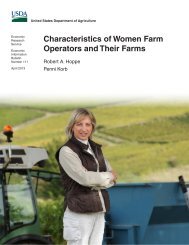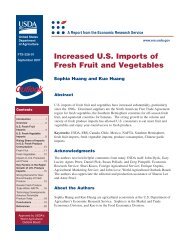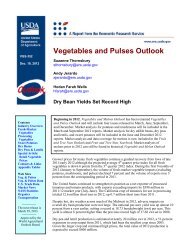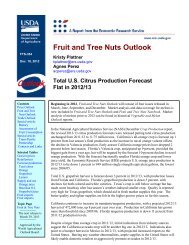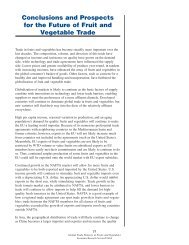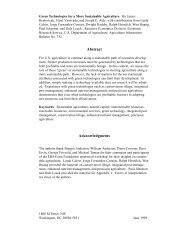Expansion of Modern Grocery Retailing and Trade in - Economic ...
Expansion of Modern Grocery Retailing and Trade in - Economic ...
Expansion of Modern Grocery Retailing and Trade in - Economic ...
You also want an ePaper? Increase the reach of your titles
YUMPU automatically turns print PDFs into web optimized ePapers that Google loves.
Supply <strong>and</strong> Dem<strong>and</strong> for <strong>Modern</strong><br />
<strong>Grocery</strong> <strong>Retail<strong>in</strong>g</strong><br />
The <strong>in</strong>troduction <strong>of</strong> modern food retail<strong>in</strong>g can <strong>in</strong>fluence food dem<strong>and</strong> <strong>in</strong><br />
develop<strong>in</strong>g countries through both price <strong>and</strong> nonprice factors. Studies identify<br />
a variety <strong>of</strong> sometimes conflict<strong>in</strong>g evidence on the approaches adopted<br />
by domestic <strong>and</strong> mult<strong>in</strong>ational modern retailers, as well as the <strong>in</strong>fluence <strong>of</strong><br />
those strategies on food dem<strong>and</strong> <strong>and</strong> market<strong>in</strong>g (Reardon <strong>and</strong> Berdegue,<br />
2002; Schwentesius <strong>and</strong> Gomez, 2002). Rather than po<strong>in</strong>t<strong>in</strong>g to one universal<br />
model, the evidence suggests that a variety <strong>of</strong> country-specific factors <strong>in</strong>fluence<br />
the level <strong>of</strong> penetration <strong>and</strong> impacts <strong>of</strong> modern formats across develop<strong>in</strong>g<br />
countries.<br />
Several nonprice factors are commonly associated with <strong>in</strong>creased dem<strong>and</strong> for<br />
food from modern formats across develop<strong>in</strong>g countries. First, modern formats<br />
better address the desire for convenience, which is be<strong>in</strong>g driven by urbanization<br />
<strong>and</strong> changes <strong>in</strong> consumer preferences (Veeck <strong>and</strong> Veeck, 2000, Gale <strong>and</strong><br />
Hu, 2007). Second, consumers <strong>of</strong>ten value modern formats because they are<br />
perceived to provide higher quality <strong>and</strong> safer food (Veeck <strong>and</strong> Veeck, 2000).<br />
Thus, dem<strong>and</strong> for modern formats can exp<strong>and</strong> as consumers place more value<br />
on food quality <strong>and</strong> safety characteristics not met by traditional retailers.<br />
Additionally, the overall dem<strong>and</strong> for modern food retail<strong>in</strong>g is associated with<br />
growth <strong>in</strong> traditional drivers <strong>of</strong> aggregate food dem<strong>and</strong>, such as <strong>in</strong>come <strong>and</strong><br />
population (Reardon et al., 2003).<br />
The expansion <strong>of</strong> modern food retail<strong>in</strong>g can also shape food dem<strong>and</strong> by<br />
<strong>in</strong>troduc<strong>in</strong>g cost advantages that improve the efficiency <strong>of</strong> food distribution<br />
<strong>and</strong> lead to lower marg<strong>in</strong>al costs compared with traditional outlets like openair<br />
markets or bodegas. First, modern grocery retailers can set up national<br />
<strong>and</strong> <strong>in</strong>ternational procurement, process<strong>in</strong>g, transportation, <strong>and</strong> distribution<br />
systems that exploit economies <strong>of</strong> scale (Boselie et al. 2003). Second, the<br />
consolidation <strong>of</strong> firms that procure goods from upstream distributors allows<br />
modern grocery retailers to barga<strong>in</strong> for better prices (Reardon et al., 2003).<br />
Also, modern retailers can access cheaper capital <strong>and</strong> benefit from foreign<br />
direct <strong>in</strong>vestments that spur transfers <strong>of</strong> technology <strong>and</strong> capital to develop<strong>in</strong>g<br />
countries (Chavez, 2002; Belik <strong>and</strong> dos Santos, 2002).<br />
The cost advantages <strong>of</strong> modern food retailers have been documented <strong>in</strong> developed<br />
countries. Artz <strong>and</strong> Stone (2006) found a 17-percent reduction <strong>in</strong> food<br />
prices paid by consumers associated with the entry <strong>of</strong> Wal-Mart supercenters<br />
<strong>in</strong> Mississippi. Hausman <strong>and</strong> Leibtag (2007), us<strong>in</strong>g a national data set, found<br />
that Wal-Mart supercenters undersold traditional supermarkets by 15-25<br />
percent. Both studies found evidence that the food price decl<strong>in</strong>es were associated<br />
with both the direct sales <strong>of</strong> the supercenters at lower prices, <strong>and</strong> subsequently<br />
reduced prices from competitor retailers.<br />
However, anecdotal evidence on whether modern retailers <strong>of</strong>fer lower prices<br />
<strong>in</strong> develop<strong>in</strong>g countries is mixed. Some studies f<strong>in</strong>d that particular prices<br />
are lower (Reardon <strong>and</strong> Berdegue, 2002), while others f<strong>in</strong>d modern retailers<br />
actually charge higher prices for many goods (Schwentesius <strong>and</strong> Gomez,<br />
2002; Far<strong>in</strong>a, 2002; Tschirley et al., 2004). In addition to the mixed evidence,<br />
these price analyses are complicated by the possibility <strong>of</strong> quality differences<br />
5<br />
The <strong>Expansion</strong> <strong>of</strong> <strong>Modern</strong> <strong>Grocery</strong> <strong>Retail<strong>in</strong>g</strong> <strong>and</strong> <strong>Trade</strong> <strong>in</strong> Develop<strong>in</strong>g Countries / ERR-122


